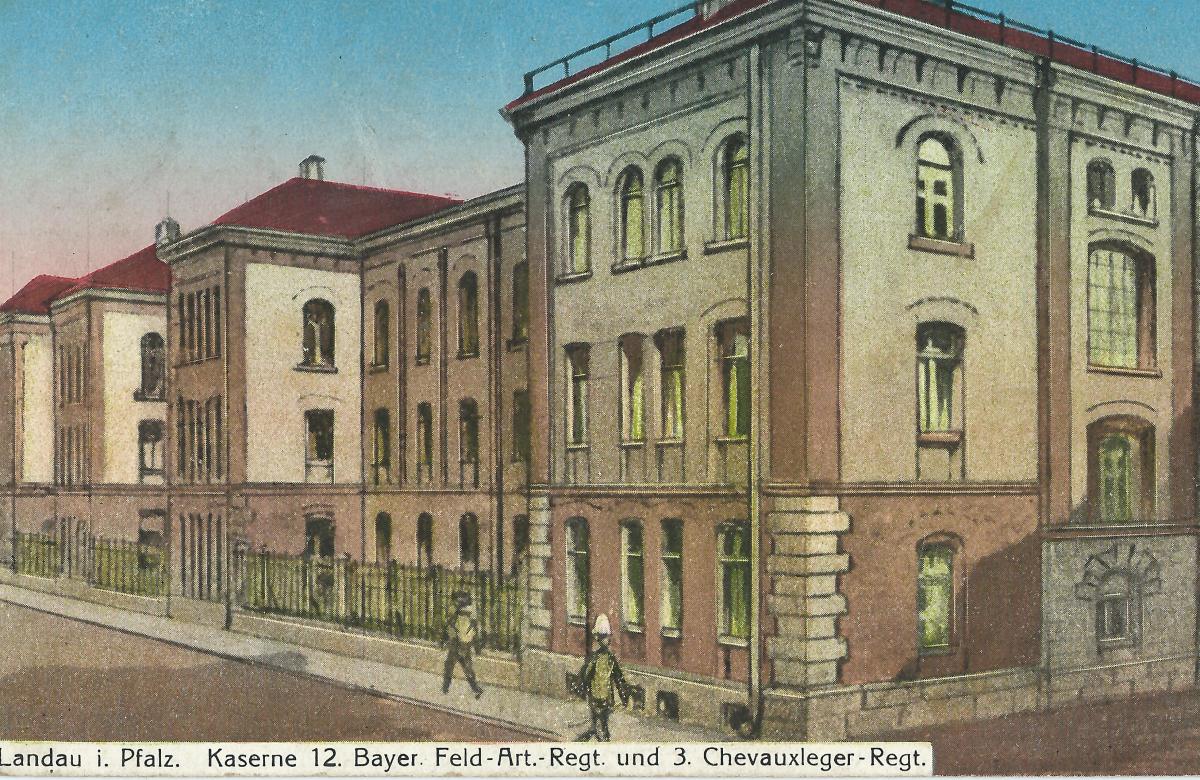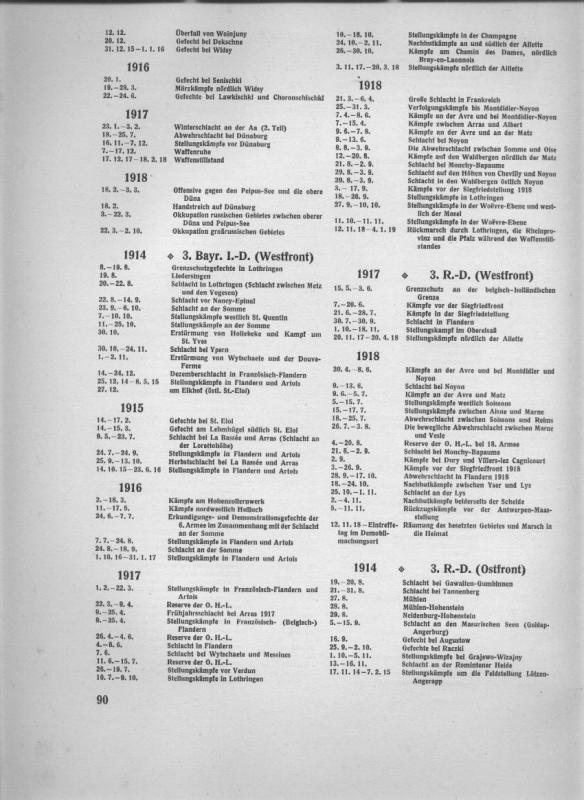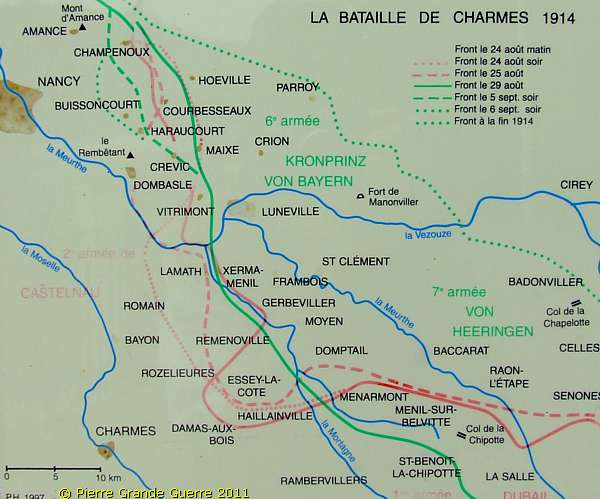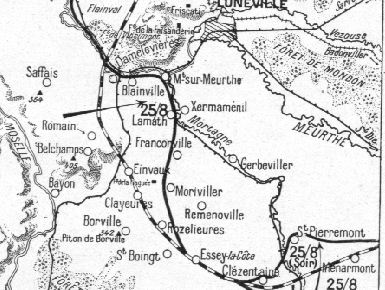Königlich Bayerisches 12. Feldartillerie-Regiment (12. bFAR)

Garrison: Landau (In der Pfalz)
Established: 1 October 1901
Brigade: 3. Königlich Bayerische Feldartillerie-Brigade
Division: 3. Königlich Bayerische Division
Kaserne 12. bFAR Landau
One of twelve active field artillery regiments of the Bavarian Army, 12. bFAR was formed in October 1901 from the III. Abteilung and the 6. Fahrenden Batterie of the Königlich Bayerisches 2. Feldartillerie-Regiment „Horn“ as well as two newly organized Fahrenden Batterien at Würzburg, Bayern. Prior to mobilization in August 1914, 12. bFAR, was garrisoned at Landau in der Pfalz, in southwestern Germany. The Regiment was subordinate to the 3. Königlich Bayerische Feldartillerie-Brigade / 3. Königlich Bayerische Division.
After mobilization, 12. bFAR remained with the redesignated 3. Bayerische Infanterie-Division throughout the war; thus earning the same campaign credits as the Division. First World War Campaigns 3. Bayerische Infanterie-Division:
The I. Abteilung 12. bFAR was armed with the 7.7cm Feldkanone (FK 96 n/A); II. Abteilung was armed with the 10.5cm leichte Feldhaubitze 98/09. In February 1916, two guns from each of the 1., 2., and 3. Batterie, were given up to form the 21. Feldartillerie-Regiment. In January 1917, 12. bFAR was enlarged with a III. Abteilung. The Stab, 7., 8., and 9. Batterie of the III. Abteilung initially fell under the command of the III. Armeekorps for training. Training was completed at the Truppenübungsplatz Thimougies in Belgium in February 1917 and the new battalion joined the Regiment in the field.
At mobilization, the 3. Bayerische Infanterie-Division was part of Kronprinz Rupprecht von Bayern’s 6. Armee. The 6. Armee was central to the bitter fighting in Alsace-Lorraine during the Battle of the Frontiers at the beginning of the war. Official German reports for August 1914 set casualty figures in the 6. Armee at 34,598, with the number of dead at 11,476. (Herwig) One of those dead was Kanonier Alois Plinganser of 5. Batt. 12. bFAR, who was killed on 24 August 1914. After holding off the French offensive in the south, 6. Armee counter-attacked on 20 August with the objective of capturing terrain south of Nancy, known as the Gap of Charmes. After initial success, the 6. Armee’s attack stalled on 24 August just east of Bayon; the French 1st and 2nd Armies counter-attacked, pushing the line back to its 14 August positions. On 24 August 1914, 12. bFAR and Kanonier Plinganser’s 5. Batterie were located at Remenoville, right in the center the brutal back and forth fighting. Early on 24 August, 3. Bayerische Infanterie-Division was given the task to open the route from Mont to Blainville; 12. bFAR was attached to the 5. b. Infantrie Brigade on the right side of the avenue of attack for this task. By early afternoon, 12. bFAR had taken up a position on Hill 251, north of Blainville, but without the 5. Batterie. The 5. Batt 12. bFAR had been fixed in its previous position by enemy artillery fire and was not able to move until the next morning (the morning of 24 August) when it took up a position south of Lamath. Infantry regiments of the 3. Bayerische Infanterie-Division continued a slow advance from Blainville toward Remenoville, supported by its own artillery, but under heavy counter-fire from French artillery. Progress was made kilometer by kilometer and by 6pm on 24 August, elements of the Division were outside Remenoville. However, during this advance, II. Abteilung 12. bFAR came under heavy French artillery fire near Franconville, a few kilometers north of Remenoville. The heaviest casualties were suffered by 5. Batt 12. bFAR. II. Abteilung 12. bFAR finally arrived at Remenoville by 7pm in the evening. Almost immediately, the German troops at Remenoville came under heavy French artillery fire and infantry attacks. By dawn on 25 August, Remenoville was in flames and the front line between German and French forces was just outside the village. Kanonier Plinganser, however, had not lived to see that dawn.
The Battle of the Charmes Gap, August 1914
Line of German Attack on 24 August
12. bFAR positions Remenoville, 24 August
Line of French Counterattack on 25 August
With the end of the war in November 1918, the III. Abteilung was dissolved, with the 7. Batterie being completely disbanded, the 8. Batterie moving to I. Abteilung, and 9. Batterie moving to II. Abteilung. The Regiment was demobilized at Ebermannstadt on 18 December 1918 and dissolved in January 1919. Elements of the Regiment became part of Frei- or Volkswehr-Batterie Zacherl, later Heyl; later these elements became 3. Batterie Reichswehr-Artillerie-Regiment 23. In August 1921, this unit became 3. Batterie des 7. (Bayerisches) Artillerie-Regiments garrisoned in Würzburg. The tradition of 12. bFAR was taken up in the Wehrmacht by the II. Abteilung des Artillerieregiments 33 in Landau und later by Artillerieregiment 69 in Mannheim.
Sources:
Kraus, Jürgen. Handbuch der Verbände und Truppen des deutschen Heeres 1914-1918. Teil IX: Feldartillerie. Band 1. Vienna: Verlag Militaria, 2007. Web (Wikipedia Deutschland). 24 August 2014
Herwig, Holger H. The Marne, 1914. New York: Random House. 2009. Print.
“Les batailles de Lorraine.” n.p. n.d. chtimiste.com/batailles1418/lorraine.htm Web. 24 August 2014
“Pierre’s Photo Impressions of the Western Front.” n.p. n.d. pierreswesternfront.punt.nl/content/2012/10/als-lorraine-gap-of-charmes Web. 24 August 2014
The Prussian and spolei. “Kgl. Bayer. 12. Feldartillerie-Regiment info needed.” GMIC.co.uk Web. 24 August 2014




8 Comments
Recommended Comments